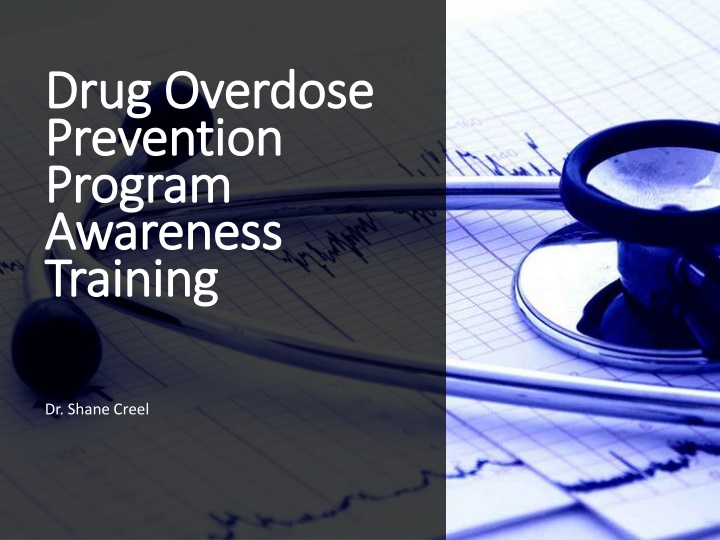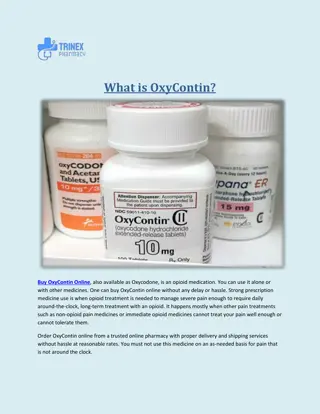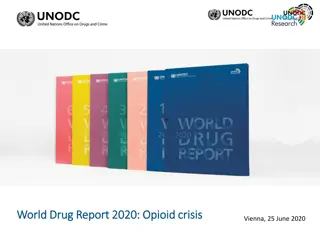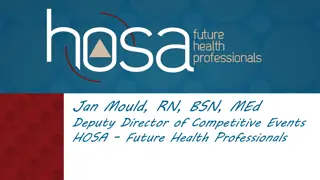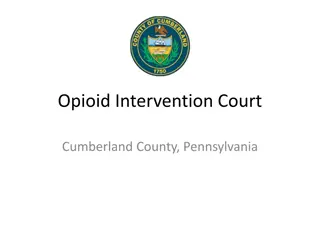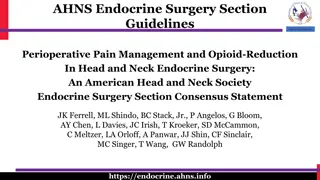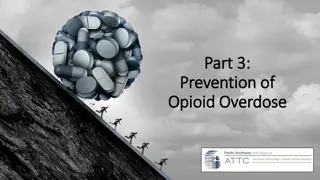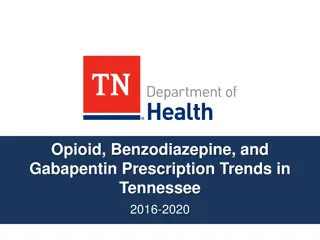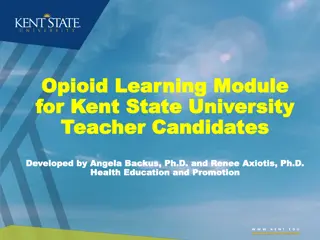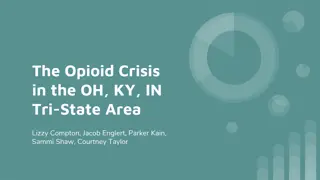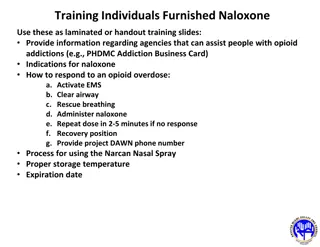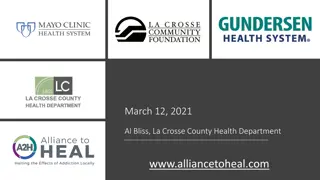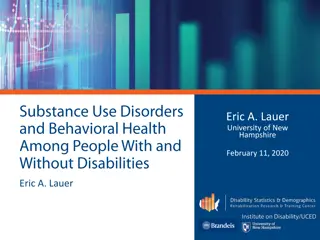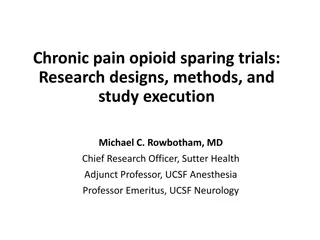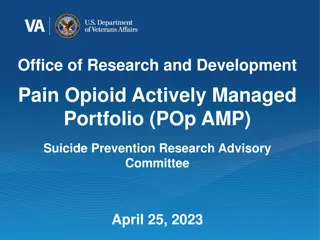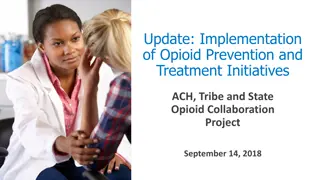Opioid Crisis Prevention and Awareness Program Overview
Opioids, including prescription medications and illegal substances like heroin, have led to a national epidemic of overdose deaths. This program aims to raise awareness, provide training on identifying overdoses, responding with Naloxone, and offering treatment referrals. The initiative addresses the risks of opioid misuse and the increasing rates of heroin-related deaths, emphasizing the need for intervention and prevention strategies.
Download Presentation

Please find below an Image/Link to download the presentation.
The content on the website is provided AS IS for your information and personal use only. It may not be sold, licensed, or shared on other websites without obtaining consent from the author.If you encounter any issues during the download, it is possible that the publisher has removed the file from their server.
You are allowed to download the files provided on this website for personal or commercial use, subject to the condition that they are used lawfully. All files are the property of their respective owners.
The content on the website is provided AS IS for your information and personal use only. It may not be sold, licensed, or shared on other websites without obtaining consent from the author.
E N D
Presentation Transcript
Drug Overdose Drug Overdose Prevention Prevention Program Program Awareness Awareness Training Training Dr. Shane Creel
TOPICS TOPICS Overview of the Heroin/Opiate Problem Identifying Opioid Overdoses How to Respond to an Overdose Use of Naloxone After Naloxone Outreach Efforts/Treatment Referrals
Opioids Opioids Opioids are a type of drugs in both legal (prescription medications such as oxycodone, hydrocodone, morphine, fentanyl) and illegal(heroin) forms. Opioids are natural or synthetic substances that act on the brain Opioids dull pain and relieve anxiety. People may misuse opioids because they are in pain (physical and emotional) and opioids produce a relaxed feeling.
A NATIONAL EPIDEMIC Between 1999 - 2017, Deaths from prescription opioid overdose death ae more than five times higher in 2017 v. 1999. In 2017, 47,600 deaths occurred as a result of an overdose from a prescription painkiller. On average, 130 Americans die every day from an opioid overdose. Every day, over 1,000 people are treated in emergency departments for misusing prescription opioids.
According to the Centers for Disease Control: Since 2010, Heroin-related overdose deaths have increased five-fold. 15,482 people died in 2017 from heroin overdose. Among new heroin users, approximately three out of four report having abused prescription opioids prior to using heroin.
Texas Opioid Summary Texas continues to have one of the lowest rates of drug overdose deaths involving opioids. In 2017, there were 1,458 overdose deaths involving opioids in Texas a rate of 5.1 deaths per 100,000 persons, compared to the national rate of 14.6 deaths per 100,000 A rising trend in opioid-involved overdose deaths was seen in cases related to synthetic opioids (mainly fentanyl) or heroin. Over the last decade, deaths involving fentanyl tripled from 118 in 2007 to 348 deaths in 2017. Source: Illinois Department of Public Health
Who is at risk of an overdose? Switching between prescriptions Mixing opioids with other prescriptions People with chronic medical conditions (HIV, cardiovascular or respiratory disease, mental illnesses) Recently released from incarceration and in-patient Tx programs. Recently completing a mandatory opioid detoxification or having abstained from use for a period of time Discharge from emergency medical care after opioid intoxication
Strategies to prevent overdose death Talk to people and caregivers about ways to avoid an accidental overdose, especially at discharge: Do not adjust prescribed dosage, skip doses, or take any extra doses Do not mix with other dugs and/or alcohol (i.e. anti-anxiety drugs like benzodiazepines, antidepressants, or cocaine) Abstain from use of opioids unless prescribed, and attempt abstinence from heroin. 2018 Opioid Overdose Prevention Toolkit
REALLY HIGH Muscles becomes relaxed Speech is slowed or slurred Sleepy looking OVERDOSE Pale, clammy skin Overdose Breathing is infrequent or has stopped Deep snoring or gurgling Unresponsive to any stimuli Overdose is a condition that usually occurs over 1-3 hours May be caused by: Excess intake of opioids Combination of opioid and a depressant Opioid use in someone with a medical condition When in doubt, call 911! Responsive to sternal rub, shouting, earlobe pinch Normal heart rate and/or pulse Normal skin tone Slow or no heart rate/pulse Blue lips and/or face
How Overdose Works Slow Breathing Breathing Stops Lack of oxygen may cause brain damage Heart Stops Seizure, stroke, or even death
Reversing Overdose Try to wake them up Shake them and shout If no response, grind your knuckles into the breast bone for 5 to 10 seconds Call 911 Administer Naloxone Check for breathing/ give rescue breathing Stay with the person until help arrives
ACTION PLAN STEPS Step 1: Recognizing an overdose Step 2: Attempt to Arouse Sternal Rub Step 3: Calling 9-1-1 Step 4: Administer naloxone, Rescue Breathing Step 5: Stay Until Help Arrives
TIPS for Calling 9 TIPS for Calling 9- -1 1- -1 1 & Naloxone & Naloxone Whichever you can do the quickest DO FIRST! Tell the dispatcher the person has stopped breathing The dispatcher may give instructions on rescue breathing or chest compressions Have the address and location ready The dispatcher may connect you with the paramedics who will ask you the same questions this is a normal process.
Rescue Breathing Rescue Breathing Please review the steps below to perfect your rescue breathing technique: 1. Be sure the person s airway is clear (check that nothing inside the person s mouth or throat is blocking the airway 2. Place one hand on the person s chin, tilt the head back. 3. Pinch the nose closed. 4. Place your mouth over the person s mouth to make a seal and give 2 slow breaths. 5. The person s chest should rise (but not the stomach). 6. Follow up with one breath every 5 seconds until the person can breath on their own
Medicated Assisted Treatment (MAT) After testing different treatments for over 25 years, M.A.T. was the one that showed the most success. There are 3 forms: Methadone, Combination Buprenorphine/Naloxone, Vivitrol. They are all affective and the treatment center will decide which is best. SAMSHA Treatment Locator: Convenient and Easy to use Behavioral Health and Substance Abuse Treatment locator: https://findtreatment.samhsa.go v/locator
